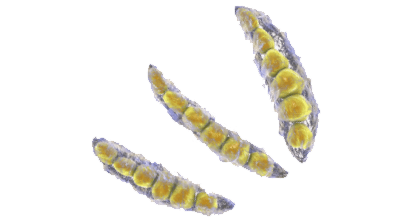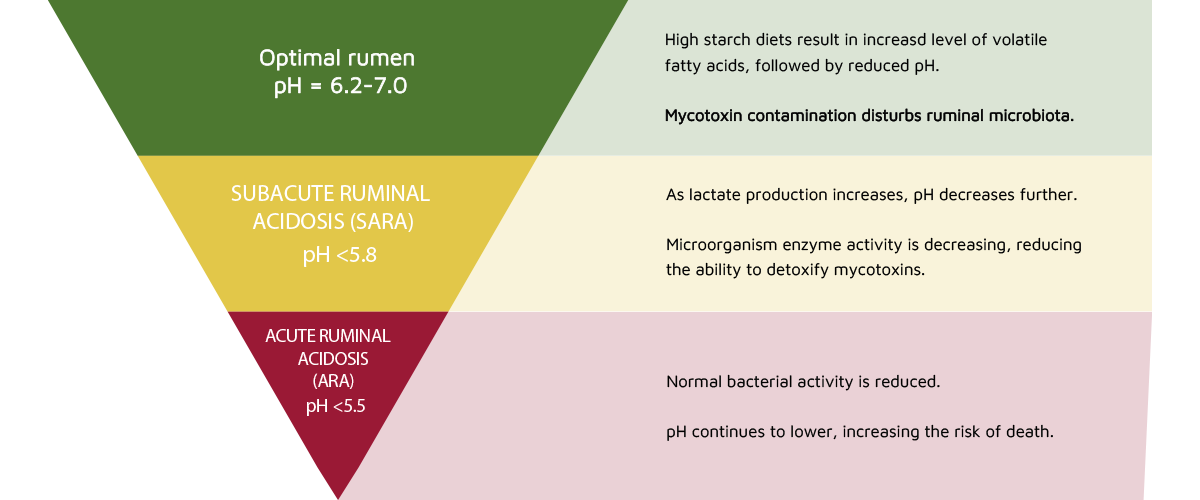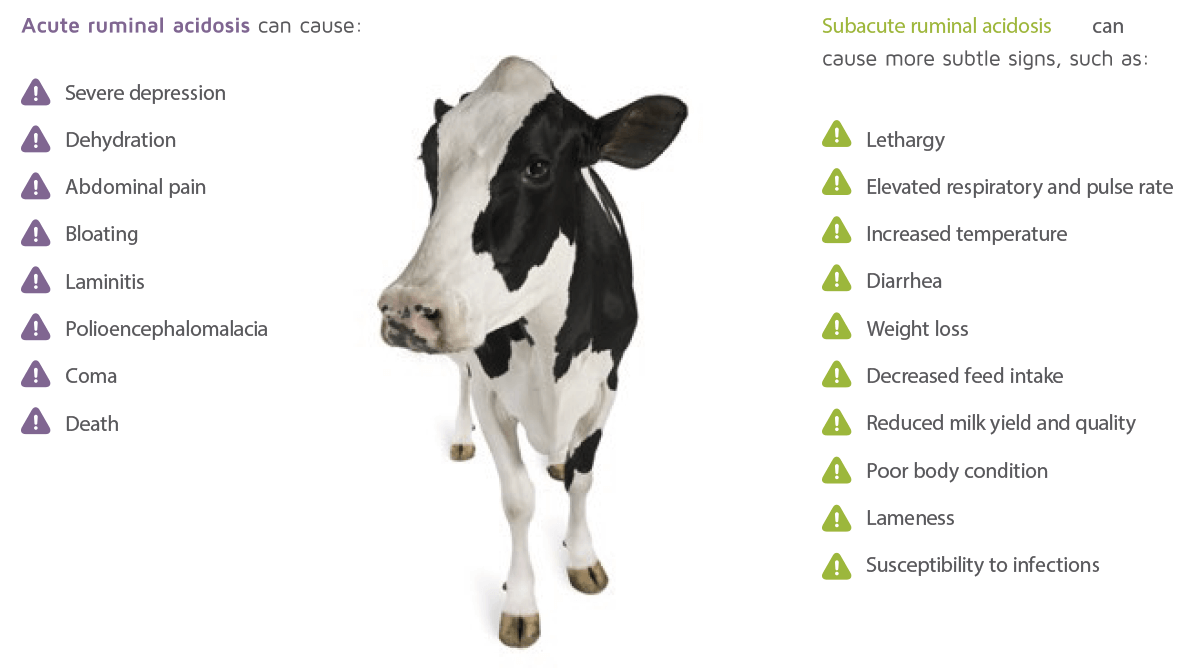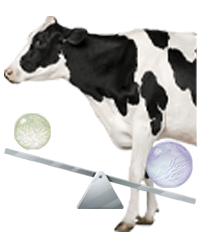Mycotoxins are toxic secondary metabolites produced by fungi that contaminate agricultural crops, causing a variety of adverse health effects and posing a serious health threat, both to humans and livestock.
The effects of mycotoxins on dairy cows depend on the type, level, and duration of exposure, as well as the physiological status and immune response of the animals.

Traditionally, ruminants were considered to be resistant to the negative effects of mycotoxins due to their detoxification in the rumen.
![]() However, high-producing dairy cows today are more sensitive to mycotoxicosis because of their high feed intake.
However, high-producing dairy cows today are more sensitive to mycotoxicosis because of their high feed intake.
This leads to faster passage of feed through the digestive tract and, consequently, lower time for mycotoxin detoxification by rumen microbes.
In addition to this, high-producing dairy cows are fed diets containing high amounts of fermentable carbohydrates to meet their energy requirements, which increases the risk of ruminal acidosis.
Symptoms of mycotoxicosis in dairy cows can be vague and nonspecific, including:
 Reduced feed intake
Reduced feed intake Feed refusal
Feed refusal Rough hair coat
Rough hair coat Poor body condition
Poor body condition Reproductive problems
Reproductive problems

Effects of mycotoxins on the cellulolytic rumen bacteria
The rumen is a complex microbial ecosystem that harbors diverse populations of bacteria, archaea, protozoa, and fungi that are involved in the anaerobic digestion of plant biomass.
Among them, cellulolytic bacteria play a key role in the hydrolysis of cellulose, the most abundant polysaccharide in nature, into glucose and other fermentable sugars.

![]() The exposure of ruminants to mycotoxins can affect the rumen microbial balance and impair the cellulolytic function of rumen bacteria (Guerre, 2020).
The exposure of ruminants to mycotoxins can affect the rumen microbial balance and impair the cellulolytic function of rumen bacteria (Guerre, 2020).
Studies have reported that mycotoxins, such as AF, OTA, ZEN, and fusaric acid, can inhibit the growth and activity of rumen cellulolytic bacteria, such as Fibrobacter succinogenes, Ruminococcus albus, Ruminococcus flavefaciens, and Butyrivibrio fibrisolvens.
The mechanisms of mycotoxin toxicity on rumen bacteria are not fully understood, but they may involve:
 Oxidative stress
Oxidative stress Membrane damage
Membrane damage Enzyme inhibition
Enzyme inhibition DNA damage
DNA damage Interference with metabolic pathways
Interference with metabolic pathways
 One of the main consequences of mycotoxin exposure in dairy cows is the alteration of rumen function and fermentation.
One of the main consequences of mycotoxin exposure in dairy cows is the alteration of rumen function and fermentation.The rumen is a complex ecosystem where microbial populations degrade feed components and produce VFAs, ammonia, gases, and microbial protein.
The rumen also plays an important role in the detoxification of some mycotoxins, such as DON
However, high levels of mycotoxins or their metabolites can impair the rumen microbial activity and diversity, leading to reduced feed intake, digestibility, and nutrient utilization.
The reduction of cellulolytic bacteria in the rumen can lead to:
 Decreased fiber digestion
Decreased fiber digestion Lower VFA production
Lower VFA production Reduced feed intake and efficiency
Reduced feed intake and efficiency Impaired animal performance and health
Impaired animal performance and health

Ruminal acidosis
Ruminal acidosis is a metabolic disorder characterized by a low rumen pH due to excessive accumulation of VFA and lactate in the rumen.
Ruminal acidosis can be classified as acute or subacute, depending on the severity and duration of the pH depression:
⇰ Acute ruminal acidosis (ARA) is a life-threatening condition that occurs when cows consume large amounts of rapidly fermentable carbohydrates, such as grain or starch.
⇰ Subacute ruminal acidosis (SARA) is a more common and chronic condition that occurs when cows are fed high-grain diets with insufficient fiber or buffering capacity.
SARA can cause reduced feed intake, milk production, milk fat content, rumination, and fiber digestion, as well as increased inflammation, lameness, liver abscesses and mastitis.

The symptoms of ruminal acidosis vary depending on the type and degree of the disorder (Enemark, 2002).

Several studies have shown that mycotoxins can contribute to the development of ruminal acidosis in dairy cows through different mechanisms:
 DON and FUM can reduce the rumen pH and increase the risk of SARA by stimulating the production of VFA and lactate by rumen microbes.
DON and FUM can reduce the rumen pH and increase the risk of SARA by stimulating the production of VFA and lactate by rumen microbes. DON can also inhibit the activity of lactate-utilizing bacteria and impair ruminal motility, which can worsen the acidosis.
DON can also inhibit the activity of lactate-utilizing bacteria and impair ruminal motility, which can worsen the acidosis. AF can impair rumen detoxification capacity by reducing the activity of glutathione S-transferase, an enzyme involved in the conjugation of AF with glutathione. It can also reduce feed intake and rumination, which can affect the rumen buffering and mixing.
AF can impair rumen detoxification capacity by reducing the activity of glutathione S-transferase, an enzyme involved in the conjugation of AF with glutathione. It can also reduce feed intake and rumination, which can affect the rumen buffering and mixing. ZEN can alter the rumen microbial composition by increasing the abundance of Firmicutes and decreasing the abundance of Bacteroidetes. It can also affect the rumen epithelium by increasing its permeability and inflammation, facilitating the translocation of endotoxins and bacteria into the bloodstream.
ZEN can alter the rumen microbial composition by increasing the abundance of Firmicutes and decreasing the abundance of Bacteroidetes. It can also affect the rumen epithelium by increasing its permeability and inflammation, facilitating the translocation of endotoxins and bacteria into the bloodstream. OTA can reduce feed intake and digestion in dairy cows, which can affect the rumen fermentation and pH. It can also induce oxidative stress and inflammation in the rumen epithelium, which can impair its barrier function and integrity.
OTA can reduce feed intake and digestion in dairy cows, which can affect the rumen fermentation and pH. It can also induce oxidative stress and inflammation in the rumen epithelium, which can impair its barrier function and integrity.
 The synergistic effects of more mycotoxins may also exacerbate the negative effects on cow health and performance, as mycotoxin co-contamination is much more frequent than single contamination.
The synergistic effects of more mycotoxins may also exacerbate the negative effects on cow health and performance, as mycotoxin co-contamination is much more frequent than single contamination.

Conclusion
Mycotoxins can have a significant impact on the health and productivity of dairy cows, particularly in relation to acidosis.
The contribution of mycotoxins to the development of ruminal acidosis in dairy cows can lead to negative impacts on their health, welfare, and productivity.
Therefore, it is important to prevent or reduce the exposure of dairy cows to mycotoxins by implementing good agricultural practices, feed storage and processing methods, and feed analysis and monitoring.

REFERENCES
Guerre, Philippe. 2020. “Mycotoxin and Gut Microbiota Interactions” Toxins 12, no. 12: 769. https://doi.org/10.3390/toxins12120769 Enemark, Jörg Matthias Dehn, R. J. Jorgensen and Peter St Enemark. “Rumen acidosis with special emphasis on diagnostic aspects of subclinical rumen acidosis: a review.” Veterinarija ir zootechnika 20, no. 42 (2002): 16-29.




 Micotoxicosis prevention
Micotoxicosis prevention